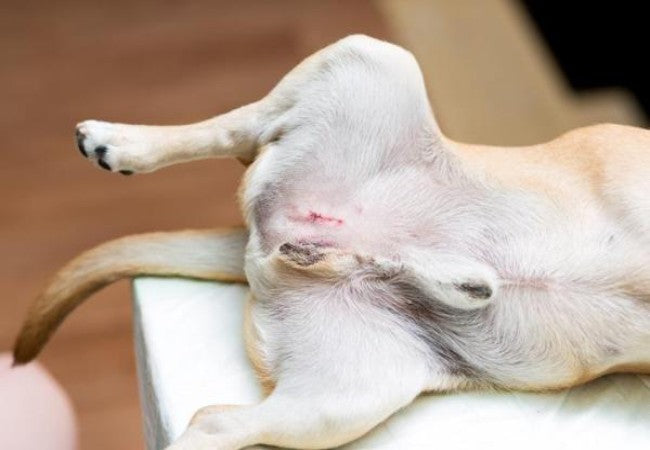Urethral Prolapse in Dogs – Vet Guide 2025 🐾🚨🩺

In this article
Urethral Prolapse in Dogs – Vet Guide 2025 🐾
By Dr. Duncan Houston BVSc
I’m Dr Duncan Houston, BVSc, founder of Ask A Vet. Urethral prolapse is a condition where the urethral mucosa protrudes from the penis tip, appearing as a small red or purple “pea” 🌡️. Mostly seen in young, intact male dogs—especially Bulldogs, Boston Terriers, and other brachycephalic breeds—it may cause discomfort, bleeding, or urinary issues. Early recognition and appropriate surgical care, combined with neutering and infection prevention, typically lead to a good outcome. Let's explore all you need to know in this comprehensive 2025 guide!
📘 What Is Urethral Prolapse?
Urethral prolapse occurs when the mucosal lining of the urethra everts through the external urethral opening, forming a visibly protruded tissue at the penis tip. Often it looks like a small red/purple bump that can worsen with excitement, straining, or licking.
🧬 Affected Dogs & Risk Factors
- Predominantly young (<2 years), intact male dogs.
- Breeds most at risk: English & French Bulldogs, Boston Terriers, Yorkshire Terriers—risk ~350× higher in English Bulldogs.
- Hypothesized factors: brachycephalic-related increased abdominal pressure, sexual excitement, urinary infections, and anatomical defects.
🚩 Symptoms to Watch For
- Visible red or purple tissue protruding from penis tip (“pea‑like”).
- Bleeding, intermittent, or ongoing.
- Pain or discomfort—licking, whining during urination.
- Straining to urinate or reduced urine flow.
- Swelling and potential ulceration if untreated.
🔍 Diagnosis
- Physical exam: visible prolapsed tissue gives a diagnosis in most cases.
- Urinalysis & culture: to detect infections or inflammation.
- Bloodwork: for general health assessment before anesthesia.
- Imaging (X-ray, ultrasound, CT/MRI): rule out urinary stones, bladder, prostate disease.
- Cytology/biopsy: to exclude neoplasia when atypical.
💉 Treatment Options
🔧 Conservative Management
Manual reduction under anesthesia with urethral catheter placement plus a temporary purse‑string suture may work for mild, non‑bleeding cases, but recurrence is common.
🔪 Surgical Options
- Urethropexy: sutures anchor the mucosa in place; moderate recurrence rates (~38%).
- Resection & anastomosis: removal of prolapsed tissue with surgical reconnection—lower recurrence (~11%) and now the gold standard.
- Combined techniques: mixing both approaches shows ~12% recurrence.
- Laser resection: emerging option; may reduce bleeding but has similar outcomes to traditional surgery.
✂️ Neutering & Medical Management
Neutering at or before surgery reduces sexual excitement, a key trigger. Antibiotics for UTI treatment, and sedatives or anti-excitement meds (e.g., diethylstilbestrol) in select cases.
📅 Post‑Op & Home Care
- Elizabethan collar 10–14 days to prevent licking.
- Restricted activity—no running, jumping.
- Post-op analgesia (e.g., tramadol) and anti‑inflammatories.
- Monitor bleeding; mild oozing is common for ~1 week.
- Follow-up exams 1–2 weeks post-surgery; catheter removal if still present.
- Continue antibiotics up to 2 weeks or per culture guidance.
⏳ Prognosis & Prevention
- Overall prognosis is good with surgical correction—most dogs regain normal urethral function.
- Recurrence rates vary: ~39% with urethropexy vs ~11% with resection/anastomosis.
- Complications: bleeding, wound disruption, stricture; sedation post-op helps reduce recurrence.
- Neutering, reducing excitement, and treating UTIs help prevent recurrence.
✨ Key Takeaways
- Urethral prolapse is most common in young, intact male, brachycephalic dogs; looks like a red/purple pea at penis tip.
- Diagnosis is based on exam; imaging and urinalysis help rule out other issues.
- Surgical resection & anastomosis have the lowest recurrence and are preferred when possible.
- Neutering, infection control, and post-op care are vital for recovery.
- Prognosis is excellent with early treatment; recurrence is prevented with optimal management.
🐾 Ask A Vet
- Get expedited specialist care and surgical planning via Ask A Vet.
If you notice a red or purple bump at your dog’s penis tip—especially if bleeding, licking, or discomfort occur—contact your vet or Ask A Vet promptly. Timely surgical care and neutering can restore function and prevent recurrence. 🩺






